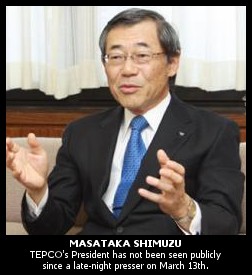
As we noted in today's Green News Report for radio, Japan's Prime Minister Naoto Kan told Parliament on Tuesday that the country remains on "maximum alert" in regard to the Fukushima Daiichi nuclear crisis as Tokyo Electric Power Co. (TEPCO) workers and members of the country's Self-Defense Force continue to struggle heroically to prevent complete meltdowns at four of the plant's six reactors. They were each knocked out of commission by the March 11th magnitude 9.0 earthquake and subsequent tsunami.
Kan was, for the first time, publicly critical of TEPCO's inadequate safety measures for the plant where, as AP detailed in an investigative report on Sunday, the company had "dismissed important scientific evidence and all but disregarded 3,000 years of geological history," when planning safe-guards against tsunamis there.
"It's undeniable their assumptions about tsunamis were greatly mistaken," Kan explained on Tuesday. Engineers had designed the plant to withstand waves of up to 18 feet, while the wave that swamped the nuclear plant knocking out power and flooding back-up diesel generators in the basement was believed to be more than 40 feet high...
Work continues to try and pump out highly radioactive water discovered from the basements and adjoining tunnels at the reactor units, so that electricity can be fully reconnected and cooling pumps repaired and restored. That effort is now being hampered by a lack of available containers to pump the contaminated water into. The hope is to keep the water from flooding into the environment on land or into the sea. Workers have been piling sandbags (pretty low-tech, eh?) to keep the flooded tunnels from overflowing into the ocean. As the LA Times reports, "The water is highly radioactive and international law forbids its release into the sea."
Fear of those tunnels overflowing has meant that new water being injected into the troubled reactors has been slowed and, therefore, so has the cooling of the nuclear fuel rods in those reactors where, officials believe, partial meltdowns have already occurred.
Radiation in sea water around the plant was as high as 1,850 times above normal levels over the weekend, though in the last 24 hours or so, that level has begun to subside a bit. For now. The latest levels of iodine-131 detected in the nearby sea water was "only" 1,150 times the maximum allowable levels. Radioactive cesium-137 has also been measured off shore, some 1,000 feet from the plant, at 20 times normal levels, approximately what it had been a week ago.
[Update: Just after publication of this article, Japan's Nuclear and Industrial Safety Agency announced new readings of radiation in sea water near the plant had spiked to 3,555 times the legal limit.]
Officials maintain that the high levels of radiation in the ocean have, so far, only been found within the 20 kilometer exclusion zone around the plant. NYTimes reports that the deputy director of Japan's Nuclear and Industrial Safety Agency (NISA) Hidehiko Nishiyama "said there were no health concerns because there would be no fishing in the evacuation-designated area within about 12 miles of the plant."
About that claim, an emailer to The BRAD BLOG with expertise in nuclear reactors (but who wished not to be identified here) wonders how "Nishiyama and his agency intend to stop fish from swimming into and out of the evacuation zone."
Good question.
In our last detailed report on the nuclear crisis at Fukushima, we discussed the continuing errors and apologies from TEPCO officials, including the whopper that led them to announce radioactive iodine-134 levels of 10 million times that which is safe in water found in the basement of Unit 2. A few hours later, after workers were forced to beat a hasty evacuation from the area, the officials announced they had miscalculated and the water was "only" 100,000 times normal levels.
At around the same moment we filed that story, AP filed their own piece detailing even more of the "bungling [and] cover-ups [that] define TEPCO."
 TEPCO, as it turns out, is Japan's largest energy supplier, and one of the largest companies in the entire nation. Today, Washington Post has a piece on the "vanishing act" by its president Masataka Shimizu who has not been seen publicly since a late-night press conference on March 13 when he admitted that the tsunami had "exceeded our expectations."
TEPCO, as it turns out, is Japan's largest energy supplier, and one of the largest companies in the entire nation. Today, Washington Post has a piece on the "vanishing act" by its president Masataka Shimizu who has not been seen publicly since a late-night press conference on March 13 when he admitted that the tsunami had "exceeded our expectations."
WaPo reports that there have been rumors Shimizu "had fled the country, checked into a hospital or committed suicide," but the company said only that he "had suffered an unspecified 'small illness' because of overwork" after the March 11th twin-disasters struck. Company officials say he is now back at work, though few, apparently, have actually seen him.
[Note: See UPDATE at bottom of article for late details tonight on Shimizu's condition and whereabouts.]
Since the quake, tsunami and ensuing nuclear crisis, TEPCO has lost some two-thirds of its value on the Tokyo stock exchange, and anonymous sources were quoted in Yomiuri Shimbun that the company may be temporarily nationalized by the government to help pay for the enormous damages they're now facing. The government's chief spokesperson Yukio Edano, however, denies the report, saying "we're not currently considering that."
"In just over two weeks," WaPo notes, "Tepco has gone from being an economic and political powerhouse to a basket case. It is seeking two trillion yen ($25 billion) in emergency loans just to stay afloat."
Too big to fail? It all sounds familiar. Though WaPo draws this noteworthy distinction between the pay scale for TEPCO executives, versus their corporate powerhouse counterparts in the U.S.:
But it is the workers at the plant, not the company executives, who have, justifiably, earned the admiration of Japan and the rest of the world. Unlike Shimizu --- where ever he may be and whatever he may be doing --- the nameless, faceless workers continue to have their lives on the line in cleaning up after TEPCO's, and the Japanese government's, mistakes.
Reuters' Kazunori Takada offers us one of the first glimpses of the daily lives and horrible living conditions of the tireless workers at the Fukushima Daiichi nuclear power plant, where their Herculean task may have to continue, according to officials, for months or even years...
That's the grim lot of hundreds of workers toiling in perilous conditions to avert a catastrophic nuclear meltdown at Japan's earthquake-wrecked Fukushima power plant.
"This is similar to a war zone and things need to be addressed, including providing proper back-up for the workers who are under immense stress," said Hirotada Hirose, professor of disaster psychology at Tokyo Woman's Christian University.
"If this continues, productivity and morale will fall and workers will become likely to make mistakes. We cannot afford that," Hirose told Reuters.
...
The air around the plant is so contaminated by radiation that the men have to wear masks even when they are huddled inside the so-called safe room where they eat and sleep. They eat only packaged food, ramming it quickly into their mouths as soon as it is opened to avoid contact with radiation.
...
Early in the evening, they gather around to raise their spirits before wrapping themselves in blankets to sleep on the floor.
UPDATE: Not long after we filed this report, comes this from Kyodo: "TEPCO to improve tough working conditions at Fukushima nuclear plant"
UPDATE 9:31pm PT: Daily Yomiuri tweets Shimizu has been hospitalized: "TEPCO says its president has been hospitalized due to dizzy spells, high blood pressure. He was due to hold a press conference today." | More details now here...
A 3/28/11 report from ABC News, on TEPCO's failures, including design flaws at the plant, follows below...
Today's six-minute Green News Report for radio, detailing disturbing news revealed at Congressional hearings this week on U.S. plans for evacuations around nuclear power plants in this country, and much more, is right here.
Our most recent detailed report in our more than two weeks of nearly non-stop coverage of the Fukushima crisis is here.
Please follow our 24/7 coverage of noteworthy breaking news on Fukushima via Twitter: @TheBradBlog.


 Sunday 'Close Enough' Toons
Sunday 'Close Enough' Toons A Pretty Weak 'Strongman': 'BradCast' 10/30/25
A Pretty Weak 'Strongman': 'BradCast' 10/30/25 'Green News Report' 10/30/25
'Green News Report' 10/30/25
 Proposal for 'First Politically Viable Wealth Tax' Takes Shape in CA: 'BradCast' 10/29/25
Proposal for 'First Politically Viable Wealth Tax' Takes Shape in CA: 'BradCast' 10/29/25 Monster Storm, Endless Wars, Gamed Elections:
Monster Storm, Endless Wars, Gamed Elections: 'Green News Report' 10/28/25
'Green News Report' 10/28/25 Let's Play 'Who Wants
Let's Play 'Who Wants Sunday 'Cartoonists Dilemma' Toons
Sunday 'Cartoonists Dilemma' Toons Exiled NOAA Scientists Resurrect Critical Disaster Database: 'BradCast' 10/23/25
Exiled NOAA Scientists Resurrect Critical Disaster Database: 'BradCast' 10/23/25  'Green News Report' 10/23/25
'Green News Report' 10/23/25 Trump-Allied GOP Partisan Buys Dominion Voting Systems: 'BradCast' 10/22/25
Trump-Allied GOP Partisan Buys Dominion Voting Systems: 'BradCast' 10/22/25 Trump, Republican Law(lessness) & (Dis)Order: 'BradCast' 10/21/25
Trump, Republican Law(lessness) & (Dis)Order: 'BradCast' 10/21/25 'Green News Report' 10/21/25
'Green News Report' 10/21/25 Celebrating 'No Kings': 'BradCast' 10/20/25
Celebrating 'No Kings': 'BradCast' 10/20/25 Sunday 'How It Started' Toons
Sunday 'How It Started' Toons SCOTUS Repubs Appear Ready to Gut Rest of Voting Rights Act: 'BradCast' 10/16/25
SCOTUS Repubs Appear Ready to Gut Rest of Voting Rights Act: 'BradCast' 10/16/25 'Green News Report' 10/16/25
'Green News Report' 10/16/25 The 'Epstein Shutdown' and Other Autocratic Nightmares: 'BradCast' 10/15/25
The 'Epstein Shutdown' and Other Autocratic Nightmares: 'BradCast' 10/15/25 Group Vows to Block MO's GOP U.S. House Gerrymander: 'BradCast' 10/14/25
Group Vows to Block MO's GOP U.S. House Gerrymander: 'BradCast' 10/14/25 Trump Labor Dept. Warns Trump Policies Sparking Food Crisis: 'BradCast' 10/9/25
Trump Labor Dept. Warns Trump Policies Sparking Food Crisis: 'BradCast' 10/9/25 Trump's Losing Battles: 'BradCast' 10/8/25
Trump's Losing Battles: 'BradCast' 10/8/25 Trump, Roberts and His Stacked, Packed and Captured SCOTUS: 'BradCast' 10/7/25
Trump, Roberts and His Stacked, Packed and Captured SCOTUS: 'BradCast' 10/7/25 Trump Attempting His 'Invasion from Within': 'BradCast' 10/6/25
Trump Attempting His 'Invasion from Within': 'BradCast' 10/6/25 Biden Budget Expert: Mass Firings in Shutdown 'Illegal': 'BradCast' 10/2/25
Biden Budget Expert: Mass Firings in Shutdown 'Illegal': 'BradCast' 10/2/25 Why is DOJ Suing 'Blue' States for Their Voter Databases?: 'BradCast' 10/1/25
Why is DOJ Suing 'Blue' States for Their Voter Databases?: 'BradCast' 10/1/25
 VA GOP VOTER REG FRAUDSTER OFF HOOK
VA GOP VOTER REG FRAUDSTER OFF HOOK Criminal GOP Voter Registration Fraud Probe Expanding in VA
Criminal GOP Voter Registration Fraud Probe Expanding in VA DOJ PROBE SOUGHT AFTER VA ARREST
DOJ PROBE SOUGHT AFTER VA ARREST Arrest in VA: GOP Voter Reg Scandal Widens
Arrest in VA: GOP Voter Reg Scandal Widens ALL TOGETHER: ROVE, SPROUL, KOCHS, RNC
ALL TOGETHER: ROVE, SPROUL, KOCHS, RNC LATimes: RNC's 'Fired' Sproul Working for Repubs in 'as Many as 30 States'
LATimes: RNC's 'Fired' Sproul Working for Repubs in 'as Many as 30 States' 'Fired' Sproul Group 'Cloned', Still Working for Republicans in At Least 10 States
'Fired' Sproul Group 'Cloned', Still Working for Republicans in At Least 10 States FINALLY: FOX ON GOP REG FRAUD SCANDAL
FINALLY: FOX ON GOP REG FRAUD SCANDAL COLORADO FOLLOWS FLORIDA WITH GOP CRIMINAL INVESTIGATION
COLORADO FOLLOWS FLORIDA WITH GOP CRIMINAL INVESTIGATION CRIMINAL PROBE LAUNCHED INTO GOP VOTER REGISTRATION FRAUD SCANDAL IN FL
CRIMINAL PROBE LAUNCHED INTO GOP VOTER REGISTRATION FRAUD SCANDAL IN FL Brad Breaks PA Photo ID & GOP Registration Fraud Scandal News on Hartmann TV
Brad Breaks PA Photo ID & GOP Registration Fraud Scandal News on Hartmann TV  CAUGHT ON TAPE: COORDINATED NATIONWIDE GOP VOTER REG SCAM
CAUGHT ON TAPE: COORDINATED NATIONWIDE GOP VOTER REG SCAM CRIMINAL ELECTION FRAUD COMPLAINT FILED AGAINST GOP 'FRAUD' FIRM
CRIMINAL ELECTION FRAUD COMPLAINT FILED AGAINST GOP 'FRAUD' FIRM RICK SCOTT GETS ROLLED IN GOP REGISTRATION FRAUD SCANDAL
RICK SCOTT GETS ROLLED IN GOP REGISTRATION FRAUD SCANDAL VIDEO: Brad Breaks GOP Reg Fraud Scandal on Hartmann TV
VIDEO: Brad Breaks GOP Reg Fraud Scandal on Hartmann TV RNC FIRES NATIONAL VOTER REGISTRATION FIRM FOR FRAUD
RNC FIRES NATIONAL VOTER REGISTRATION FIRM FOR FRAUD EXCLUSIVE: Intvw w/ FL Official Who First Discovered GOP Reg Fraud
EXCLUSIVE: Intvw w/ FL Official Who First Discovered GOP Reg Fraud GOP REGISTRATION FRAUD FOUND IN FL
GOP REGISTRATION FRAUD FOUND IN FL

































